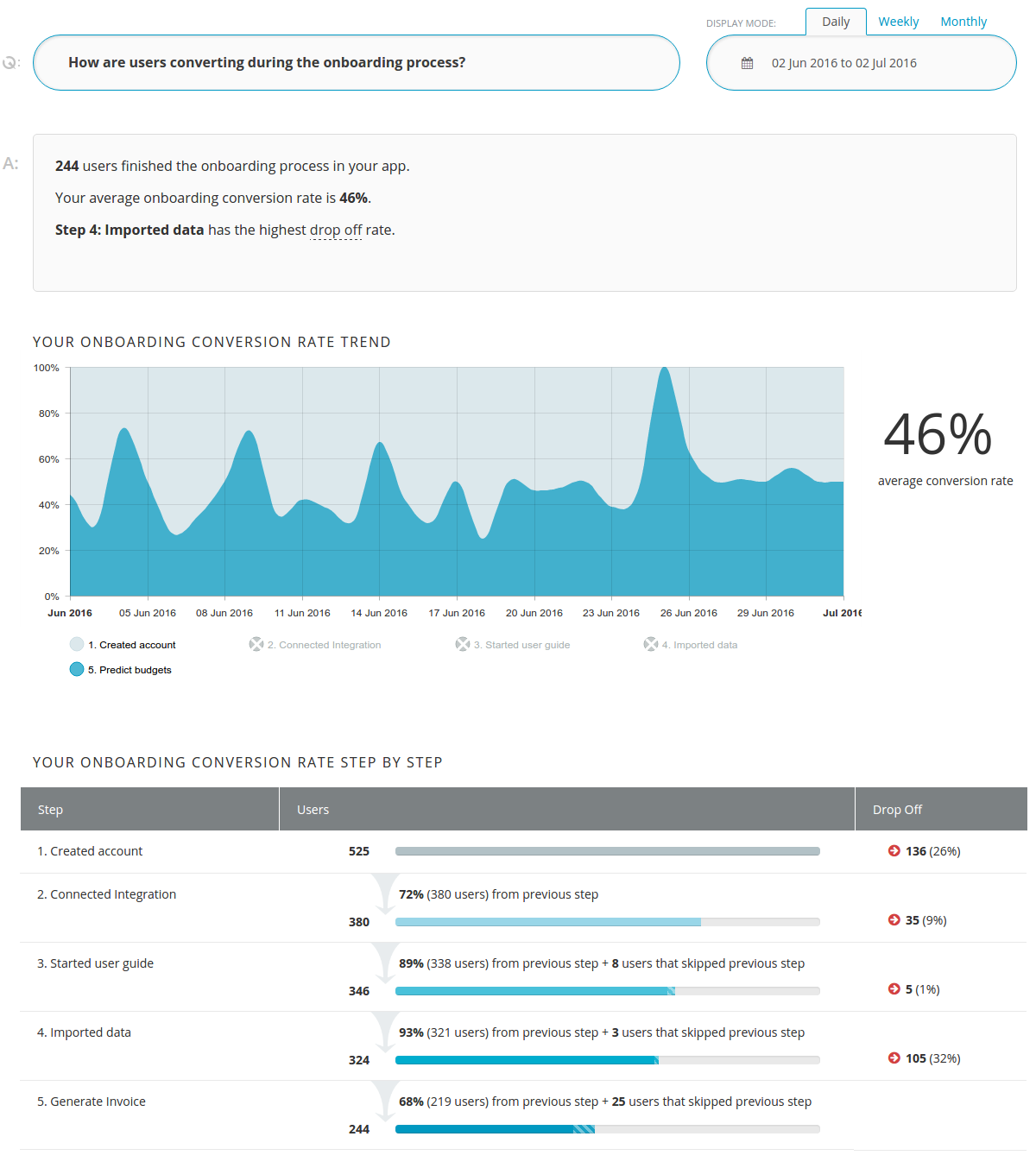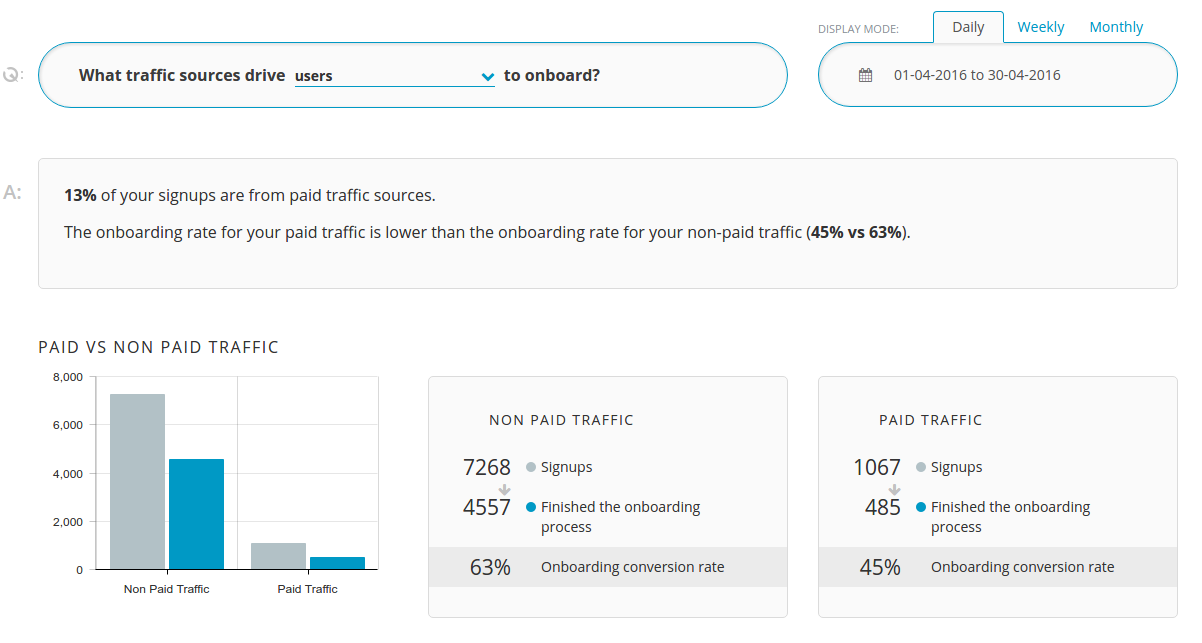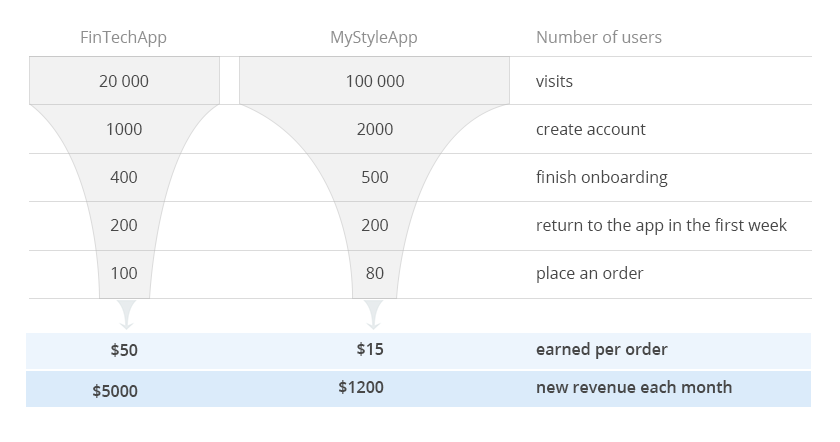This article is part 3 of 6 from our upcoming eBook, Hacking Growth With the Rule of 72. Sign up to pre-order your free copy and receive it automatically when it’s launched.
Part 1: Increasing Traffic by 12%
Part 2: Increasing the Conversion Rate by 12%
Customer Onboarding = Your Product’s First Date
The first impression your product leaves upon the user is critical. If anything goes wrong during the user onboarding process, people won’t be able to receive the value of your product.
The users might decide that your product is not worth dealing with and the return for what you’ve invested up until this point will be minimum.
If your customer onboarding process isn’t optimized in a way to help the user understand how the product will solve his problem, it’s very unlikely that he will follow through with all of the steps he needs to take in order to start receiving the value of your app.
User onboarding is the process a user goes through from the moment he signs up, right until the moment he gets to experience the core value your product has to offer.
Customer onboarding process is your chance to create a first impression compelling enough to convince your users that your product is the real deal. It’s a process you have complete control over, and you should plan to make the best out of it.
No one has the perfect onboarding process, but successful SaaS companies do their best to provide a great onboarding experience for their users.
SaaS Customer Onboarding Optimization Starter Pack
We’ve already written plenty on the topic of user onboarding and how to create your first user onboarding process. Be sure to refer to our Growth Hacker’s Guide to Onboarding Your First 100 Users if you need to set up your onboarding strategy.
Today we’re going to focus on how to optimize your SaaS onboarding rate and have more users finish the onboarding process.
In order to begin optimizing your SaaS onboarding rate, you first have to figure out where the onboarding ends. What action does your user have to complete in order to receive the value of your product? Once he goes through that, you can consider him as being onboarded.
Now that you know where to put the finish sign in your user’s onboarding journey, it’s time to do a little backwards engineering and analyze the process from your user’s perspective.
You know that you must make him reach that finish line, but where does all of it start? What is it that makes a visitor interested in receiving what your product has to offer?
Usually the first thing a visitor sees is a promise made by an ad or a landing page for your product. The promise convinces him that your product is worth a shot and he decides to test it out.
The promise has a huge impact over the onboarding process because your whole onboarding strategy must be designed to reflect and fulfill the promise made to the visitor.
Once the visitor reaches your page and finishes signing up, he will transition to the onboarding process. Here at InnerTrends we look at the onboarding process as a funnel.
In order to help you get a better understanding of the onboarding process, we help you break it down into multiple steps and allow you to track how people perform at every step.
Here is an example of how we report user activity through the onboarding process:

From what we’ve learned, there usually are one or two steps of the onboarding process where most people drop off. This means that they never get to finish the onboarding process. They get stuck somewhere and abandon the process.
Those steps can be at the beginning of the funnel, often meaning that people got to step that they didn’t expect to encounter.
It could also mean that too much effort is required of them to get past that step and they might not be ready to make that commitment just yet.
If those steps are towards the end of the funnel, in many cases people could be having trouble getting approval for technical stuff, or they could lack the skills or the information required for them to continue.
Once you know exactly how your users perform every step of the way, you’ll be able to spot the leaks and start coming up with solutions in order to optimize the onboarding process, and improve their experience.
Analyzing User Behavior During Onboarding
The next step is to analyze their behavior to see what makes them abandon the onboarding process. We like to split this process in three steps:
- What happens before users decide to onboard your app
- What happens during the first user experience
- What is the behavior of onboarded users and how many of them reach specific goals
You need to figure out how long a user has spent with your app, how much does he know what your app does, how it works, and what are the benefits will have a major impact on the user onboarding.
Users that are well documented, motivated and engaged, shouldn’t be intimidated by the friction that comes their way. But you still need to do your best at helping them get to end goal as soon as possible.
If creating an account is the first action users perform on your website, they’ll need to be motivated at each step of the user onboarding process.
Also, the traffic sources that drive users to create an account can have a big impact on how users behave during the onboarding process.
If you feature different promises on every traffic source, you basically set different expectations for each segment of your traffic.
If that’s the case, successfully guiding all the users through the onboarding process will be a lot more challenging. Changing the promise featured on your ads is a lot easier than making changes to your app’s onboarding process.
Check out the difference between paid and organic users onboarding behavior for a B2B app:

The first interaction a user has with your app is critical, just like when you meet someone new. As shallow as it sounds, studies have shown that the first impression we have on someone weighs much more than how that person truly is.
As an app, you’ll want to have as many friends as possible. Therefore, the way users go through your app for the first time will have a direct impact on his decision to get committed and follow through with the onboarding process.
These are some critical questions you’ll want to answer to understand how your app is performing during its first date with a user:

Users finish the onboarding process when your app delivers what the ads have promised to them. That’s the moment that a user can actually say “Yep, that’s what I needed!” also known as the “Aha! moment”.
The first date your app has with your user is one of the most crucial steps, but it’s only the first of many in the journey of converting him to a customer.
What really matters is how many of the onboarded users return to your app. You’ll have to track how many of them reach important goals and milestones and what actions influences them, and then use that information to further optimize the onboarding process.
First week retention is a good metric to help you find out whether the onboarding strategy you’ve implemented is working.
It’s one of the most important metrics to report at this stage, but we’ll talk more about that in the next article in this series where we’ll show you how to optimize it.
Optimizing The User Onboarding of Your SaaS Company
Let’s go back the two apps we’ve used to illustrate how these steps can be implemented. To refresh your mind really quick, here’s how the funnel of our two apps looks like:

B2B Customer Onboarding Optimization
FintechApp has an onboarding rate of 40%, losing most of the users at the third step of the onboarding process where users are required to connect their bank account.
Doing a further analysis on what is influencing people to drop off at this particular step helps FinTechApp discover that after selecting a bank, many users go back to the bank selection page, an action which is common to most users that are dropping off.
Because the report helped FinTechApp identify the real issue in a short amount of time, they can use this information and begin implementing growth hacks to help their users.
The product manager at FinTechApp decided to introduce live chat support during the onboarding process. This feature has only been made available to this segment of users and is only a temporary fix.
The option to chat with a representative should be able to help FinTechApp get the extra 48 users complete the onboarding process. They are all that’s needed to reach the goal.
What the team at FinTechApp learned from implementing this feature should also be valuable to them when they try to figure out the fix for this step of the user onboarding process.
B2C User Onboarding Optimization
On the other hand, MyStyleApp has an onboarding rate of 25%. They’re losing most of the users at the last step when they get asked to create their first outfit.
Analyzing their users behavior, MyStyleApp learns that while most users get to that final step in less than 15 minutes, it takes more than 5 hours for about 30% of their users to get there.
Facing a large number of users that need so much time to complete an easy task, MyStyleApp decides to send a notification to all the users stuck around 5 hours mark, and offer some outfit suggestions.
Their goal will be to convert as much as they can since they are targeting users who spent more than 5 hours trying to finish the onboarding, but didn’t complete it yet.
The math behind MyStyleApp tells them that the timing of the email will have a high impact on the 1500 monthly users it targets with the goal of converting around 60 of them. They decide to place their bet on this information.
Now that the onboarding rate is optimized, the next step is to have the onboarded users return as much as we can during the first week.
In part 4 we will have a look at how the two companies can increase their retention rate by 12%. Pre-order your copy of our free guide on how to use the rule of 72 to double growth!
Looking for deep insights into how your customers use your product?
InnerTrends can help. You won’t have to be a data scientist to discover the best growth opportunities for your business, our software will take care of that for you.
Schedule a Demo with us and witness with your own eyes just how powerful InnerTrends can be.